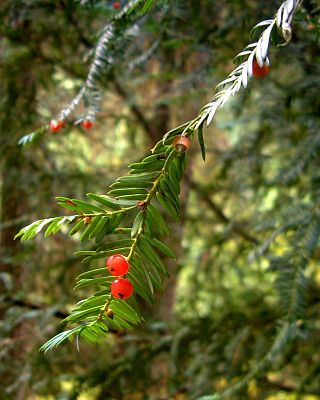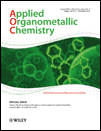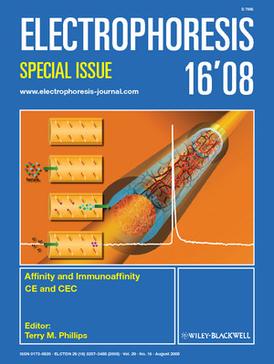
In organic chemistry, a thiol, or thiol derivative, is any organosulfur compound of the form R−SH, where R represents an alkyl or other organic substituent. The −SH functional group itself is referred to as either a thiol group or a sulfhydryl group, or a sulfanyl group. Thiols are the sulfur analogue of alcohols, and the word is a blend of "thio-" with "alcohol".
The iron–sulfur world hypothesis is a set of proposals for the origin of life and the early evolution of life advanced in a series of articles between 1988 and 1992 by Günter Wächtershäuser, a Munich patent lawyer with a degree in chemistry, who had been encouraged and supported by philosopher Karl R. Popper to publish his ideas. The hypothesis proposes that early life may have formed on the surface of iron sulfide minerals, hence the name. It was developed by retrodiction from extant biochemistry in conjunction with chemical experiments.

Myristicin is a naturally occurring compound found in common herbs and spices, the best-known being nutmeg. It is an insecticide, and has been shown to enhance the effectiveness of other insecticides in combination. Myristicin is also a precursor for substituted amphetamine derivative compounds structurally related to MMDA and MDMA; it was believed to be metabolized in the liver into MMDA, but unlikely since no MMDA was found in urine, in the body it produces hallucinogenic effects, and can be converted to MMDMA in controlled chemical synthesis. It interacts with many enzymes and signaling pathways in the body, is cytotoxic to living cells, and may also have chemoprotective properties.
PubMed is a free search engine accessing primarily the MEDLINE database of references and abstracts on life sciences and biomedical topics. The United States National Library of Medicine (NLM) at the National Institutes of Health maintain the database as part of the Entrez system of information retrieval.

In the fields of medicine, biotechnology and pharmacology, drug discovery is the process by which new candidate medications are discovered.
Cheminformatics refers to use of physical chemistry theory with computer and information science techniques—so called "in silico" techniques—in application to a range of descriptive and prescriptive problems in the field of chemistry, including in its applications to biology and related molecular fields. Such in silico techniques are used, for example, by pharmaceutical companies and in academic settings to aid and inform the process of drug discovery, for instance in the design of well-defined combinatorial libraries of synthetic compounds, or to assist in structure-based drug design. The methods can also be used in chemical and allied industries, and such fields as environmental science and pharmacology, where chemical processes are involved or studied.
Total synthesis is the complete chemical synthesis of a complex molecule, often a natural product, from simple, commercially-available precursors. It usually refers to a process not involving the aid of biological processes, which distinguishes it from semisynthesis. Syntheses may sometimes conclude at a precursor with further known synthetic pathways to a target molecule, in which case it is known as a formal synthesis. Total synthesis target molecules can be natural products, medicinally-important active ingredients, known intermediates, or molecules of theoretical interest. Total synthesis targets can also be organometallic or inorganic, though these are rarely encountered. Total synthesis projects often require a wide diversity of reactions and reagents, and subsequently requires broad chemical knowledge and training to be successful.

Medicinal or pharmaceutical chemistry is a scientific discipline at the intersection of chemistry and pharmacy involved with designing and developing pharmaceutical drugs. Medicinal chemistry involves the identification, synthesis and development of new chemical entities suitable for therapeutic use. It also includes the study of existing drugs, their biological properties, and their quantitative structure-activity relationships (QSAR).

An aroma compound, also known as an odorant, aroma, fragrance or flavoring, is a chemical compound that has a smell or odor. For an individual chemical or class of chemical compounds to impart a smell or fragrance, it must be sufficiently volatile for transmission via the air to the olfactory system in the upper part of the nose. As examples, various fragrant fruits have diverse aroma compounds, particularly strawberries which are commercially cultivated to have appealing aromas, and contain several hundred aroma compounds.

A natural product is a natural compound or substance produced by a living organism—that is, found in nature. In the broadest sense, natural products include any substance produced by life. Natural products can also be prepared by chemical synthesis and have played a central role in the development of the field of organic chemistry by providing challenging synthetic targets. The term natural product has also been extended for commercial purposes to refer to cosmetics, dietary supplements, and foods produced from natural sources without added artificial ingredients.

In organic chemistry, spiro compounds are compounds that have at least two molecular rings with only one common atom. The simplest spiro compounds are bicyclic, or have a bicyclic portion as part of the larger ring system, in either case with the two rings connected through the defining single common atom. The one common atom connecting the participating rings distinguishes spiro compounds from other bicyclics: from isolated ring compounds like biphenyl that have no connecting atoms, from fused ring compounds like decalin having two rings linked by two adjacent atoms, and from bridged ring compounds like norbornane with two rings linked by two non-adjacent atoms.

Organic & Biomolecular Chemistry is a weekly peer-reviewed scientific journal covering all aspects of organic chemistry, including organic aspects of chemical biology, medicinal chemistry, natural product chemistry, supramolecular chemistry, macromolecular chemistry, theoretical chemistry, and catalysis. It is published by the Royal Society of Chemistry. Its predecessor journals were Perkin Transactions I and Perkin Transactions II. The Executive Editor is Richard Kelly.

A cyclic compound is a term for a compound in the field of chemistry in which one or more series of atoms in the compound is connected to form a ring. Rings may vary in size from three to many atoms, and include examples where all the atoms are carbon, none of the atoms are carbon, or where both carbon and non-carbon atoms are present. Depending on the ring size, the bond order of the individual links between ring atoms, and their arrangements within the rings, carbocyclic and heterocyclic compounds may be aromatic or non-aromatic; in the latter case, they may vary from being fully saturated to having varying numbers of multiple bonds between the ring atoms. Because of the tremendous diversity allowed, in combination, by the valences of common atoms and their ability to form rings, the number of possible cyclic structures, even of small size numbers in the many billions.

Plitidepsin is a chemical compound extracted from the ascidian Aplidium albicans. It is currently undergoing clinical trial testing. It is a member of the class of compounds known as didemnins.

The Journal of Mass Spectrometry is a peer-reviewed scientific journal covering all aspects of mass spectrometry including instrument design and development, ionization processes, mechanisms and energetics of gaseous ion reactions, spectroscopy of gaseous ions, theoretical aspects, ion structure, analysis of compounds of biological interest, methodology development, applications to elemental analysis and inorganic chemistry, computer-related applications and developments, and environmental chemistry and other fields that use innovative aspects of mass spectrometry. It was established in 1968 as Organic Mass Spectrometry and obtained its current title in 1995.

Applied Organometallic Chemistry is a monthly peer-reviewed scientific journal published since 1987 by John Wiley & Sons. The editor-in-chief is Cornelis J. Elsevier.
The Journal of Labelled Compounds and Radiopharmaceuticals is a peer-reviewed scientific journal that was established in 1965. It is published in fourteen issues per year by John Wiley & Sons on behalf of the International Isotope Society and covers all aspects of research and development leading to and resulting in labelled compound preparation. The current editor-in-chiefs are R F Dannals and V Derdau.

Electrophoresis is a peer-reviewed scientific journal covering all aspects of electrophoresis, including new or improved analytical and preparative methods, development of theory, and innovative applications of electrophoretic methods in the study of proteins, nucleic acids, and other compounds.

The Journal of Natural Products is a monthly peer-reviewed scientific journal covering all aspects of research on the chemistry and/or biochemistry of naturally occurring compounds. It is co-published by the American Society of Pharmacognosy and the American Chemical Society. The editor-in-chief is Philip J. Proteau.

In chemistry, a selenosulfide refers to distinct classes of inorganic and organic compounds containing sulfur and selenium. The organic derivatives contain Se-S bonds, whereas the inorganic derivatives are more variable.














